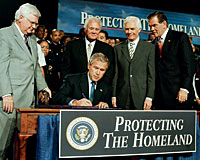
Photo: Getty
Bush administration officials used to say that the war on terrorism had to be fought “in
Baghdad, not Boston.” You don’t hear that line much anymore, yet it’s clearly
reflected in the administration’s spending priorities. The war in Iraq so far has cost $150
billion; for the Department of Homeland Security, the administration has allocated $27 billion
this year, with the bulk of that going to the routine operations of agencies like the Customs Service.
When it comes to new programs to make planes, trains, ports, and urban centers safer, there’s
precious little left over—which is why a range of critics, from local firefighters to Republican
members of Congress, have lambasted Bush for shortchanging the nation’s true homeland security
needs. Below, a sample of those needs, along with Bush’s budget allocations, compared with
the time it takes to burn through the same amount in Iraq.
Amount needed for basic security upgrades for subway and commuter trains in large cities: $6
BILLION
(Iraq spending equivalent: 20 days)
Bush budget allocation for train security: $100 MILLION
(Iraq equivalent: 8 hours)
Amount needed to equip all U.S. airports with machines that screen baggage for explosives: $3
BILLION
(Iraq equivalent: 10 days)
Bush budget allocation for baggage-screening machines: $400 MILLION
(Iraq equivalent: 32 hours)
Amount needed for security upgrades at 361 U.S. ports: $1.1 BILLION
(Iraq equivalent: 4 days)
Bush budget allocation for port security: $210 MILLION
(Iraq equivalent: 17 hours)
Amount needed to buy radiation portals for U.S. ports to detect dirty bombs in cargo: $290
MILLION
(Iraq equivalent: 23 hours)
Bush budget allocation for radiation portals: $43 MILLION
(Iraq equivalent: 3 hours)
Amount needed to help local firefighters preparefor terrorist attacks: $36.8 BILLION
(Iraq equivalent: 122 days)
Bush budget allocation for firefighter grants: $500 MILLION
(Iraq equivalent: 40 hours)
Amount needed to get local emergency medical crews ready for terrorist atttacks: $1.4 BILLION
(Iraq equivalent: 5 days)
Bush budget allocation for emergency medical training grants prior to eliminating program
altogether: $50 MILLION
(Iraq equivalent: 4 hours)
Sources:
All Bush allocation figures taken from administration estimates of FY 2005 budget
Subway and rail security upgrades
Amount needed: Statement by William W. Millar, president of the American Public Transportation Association, 5/20/04
Baggage screening
Amount needed: Government Accountability Office, “Aviation Security: Challenges Exist in Stabilizing and Enhancing Passenger and Baggage Screening Operations” [PDF], 2/12/04, p. 28
Port security upgrades
American Association of Port Authorities, “AAPA Concerned FY ’05 Lacks Funds For Port Facility Security”, 2/2/04
Radiation portals
Amount needed: Calculation based on figures from House Committee on Appropriations (Total cost of radiation portals: $495.5 million. Amount already spent: $205.5 million. Remaining amount: $290 million)
Firefighter preparedness
Amount needed: Council on Foreign Relations, “Emergency Responders: Drastically Underfunded, Dangerously Underprepared”, p. 34
Emergency medical preparedness
Amount needed: Council on Foreign Relations, “Emergency Responders: Drastically Underfunded, Dangerously Underprepared”, p. 37












